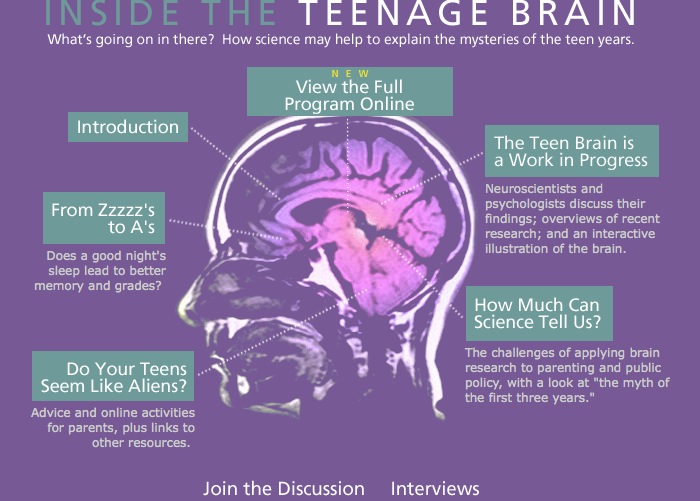This six-part series chronicles how scientists are exploring the recesses of the brain and finding some new explanations for why adolescents behave the way they do. The website that supports the series includes a rich collection of videos, links to research and other online resources about the brain, interactive diagrams, and practical tips.
http://www.pbs.org/wgbh/pages/frontline/shows/teenbrain/
(Also available on DVD for purchase)
Developed by: FRONTLINE/PBS
Audience: Educators, pre-service educators, and parents of adolescents
Potential Use: Professional Development – self-guided and group, Classroom activities, Parent/community/student discussion
This could be used for individual professional development for educators or incorporated into a group activity as a workshop. It also could be used with students and parents to increase understanding of adolescent behavior and improve communication.
Overview
In the six-part “Inside the Teenage Brain” (2002), FRONTLINE chronicles how scientists are exploring the recesses of the brain and finding some new explanations for why adolescents behave the way they do. Segments include:
- Teenagers’ Inexplicable Behavior
- The Wiring of the Teenage Brain
- Mood Swings
- “You Just Dont Understand”
- From Zzzzz’s to A’s
- Are There Lessons for Parents?
The website that supports the series includes a rich collection of videos, links to research and other online resources about the brain, interactive diagrams, and practical tips.
Good to know: a Road Map to this Resource

The series consists of six segments ranging from 7 to 12 minutes. Consider spending an hour watching the video and an hour exploring the supporting materials on the website.

No registration is needed. However you must have Adobe Flash Player installed to watch the series online.

The supporting website is divided into five sections:
Introduction
Provides an introduction to the topics covered in the series with many embedded text links to the additional resources located throughout the site.
From Zzzz’s to A’s
Includes links to several reports, research summaries, articles, and interviews about the importance of sleep in teens.
Do Your Teens Seem Like Aliens?
Gives a list of resources for parents all focused on improving communication with teens (aimed at parents but useful for educators, too).
The Teen Brain is a Work in Progress
Links to interviews with prominent neuroscientists and psychologists; feature articles on the changes in the brain occurring in adolescence, and an interactive map of the brain.
How Much Can Science Tell Us?
Provides interviews and articles that explore the challenges of applying brain research to parenting and public policy, with a look at “the myth of the first three years.”

- Easily return to the main series page by clicking on “home” in the breadcrumbs menu located in the upper right corner on most pages.
- Check out the interviews with scientists and policy makers by following the link at the bottom of the purple portion of the page.
- Access a link to purchase a DVD copy of the series or download the written transcript by selecting “tapes and transcripts” from the menu that runs across the bottom of the page.

Anatomy of a Teen Brain: This interactive map explains the basics of the teen brain. The page also includes links to a large number of other resources on the anatomy of the brain.
Video Excerpt: This two minute video is a great way to get a feel for the series to decide if you would like to watch it in full. It’s a little hard to find. Look in the menu of red text links that run across the bottom of the main page.
Interviews: Interviews with prominent neuroscientists and policy makers interested in adolescent brain development include: Jay Giedd, a neuroscientist at the National Institute of Mental Health; Mary Carskadon, a psychiatrist at Brown University who studies adolescent sleep; Deborah Yurgelun-Todd, director of cognitive neuroimaging at McLean Hospital who studies how teenage brains process emotion; and Ellen Galinsky, president of the Family and Works Institute.

Join the Discussion On this page, read letters written in reaction to the show from teens, parents, and teachers.
How does this align with student-centered learning research and practice?
This series provides a very accessible look into many of the recent neuro-scientific findings and the implications for learning which are presented in Mind, Brain, and Education. This resource provides research and information that supports the utility of the Students at the Center framework.
